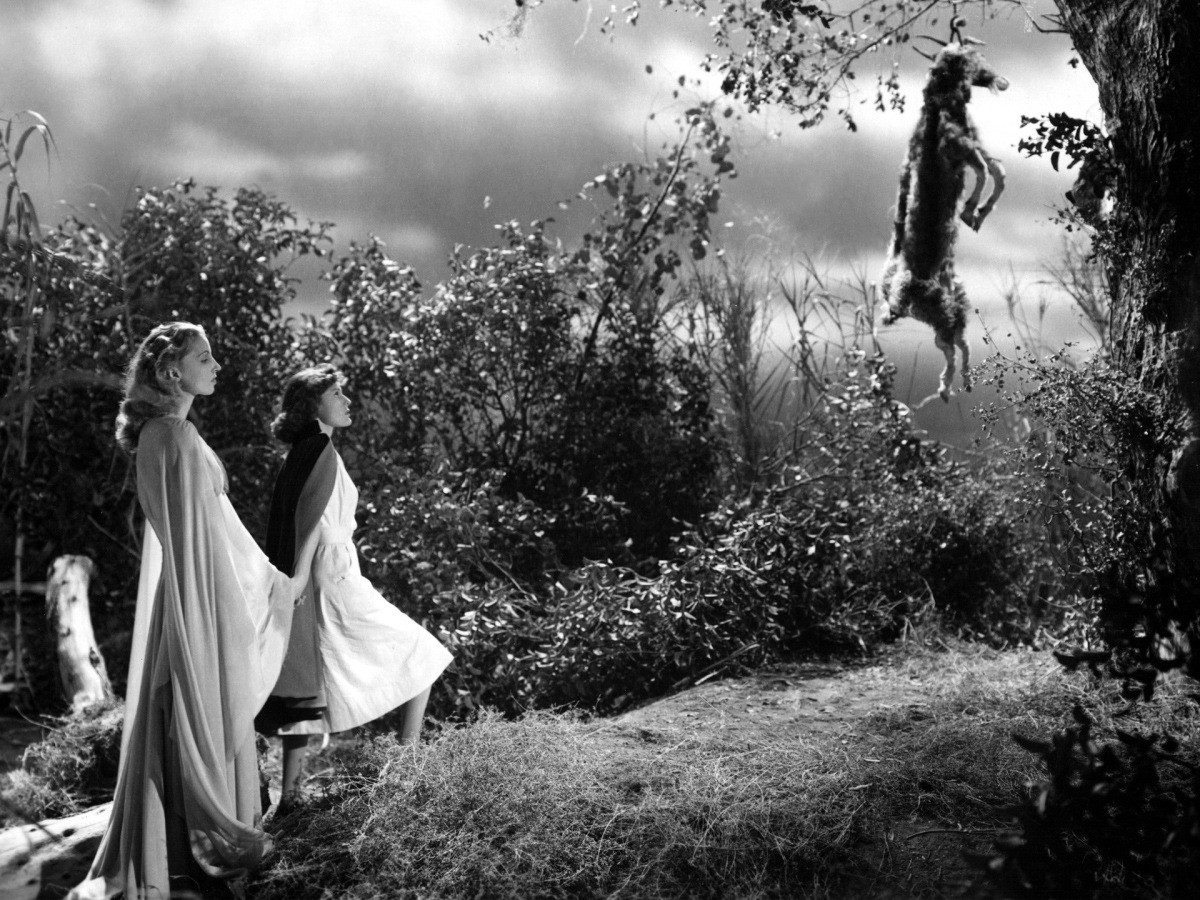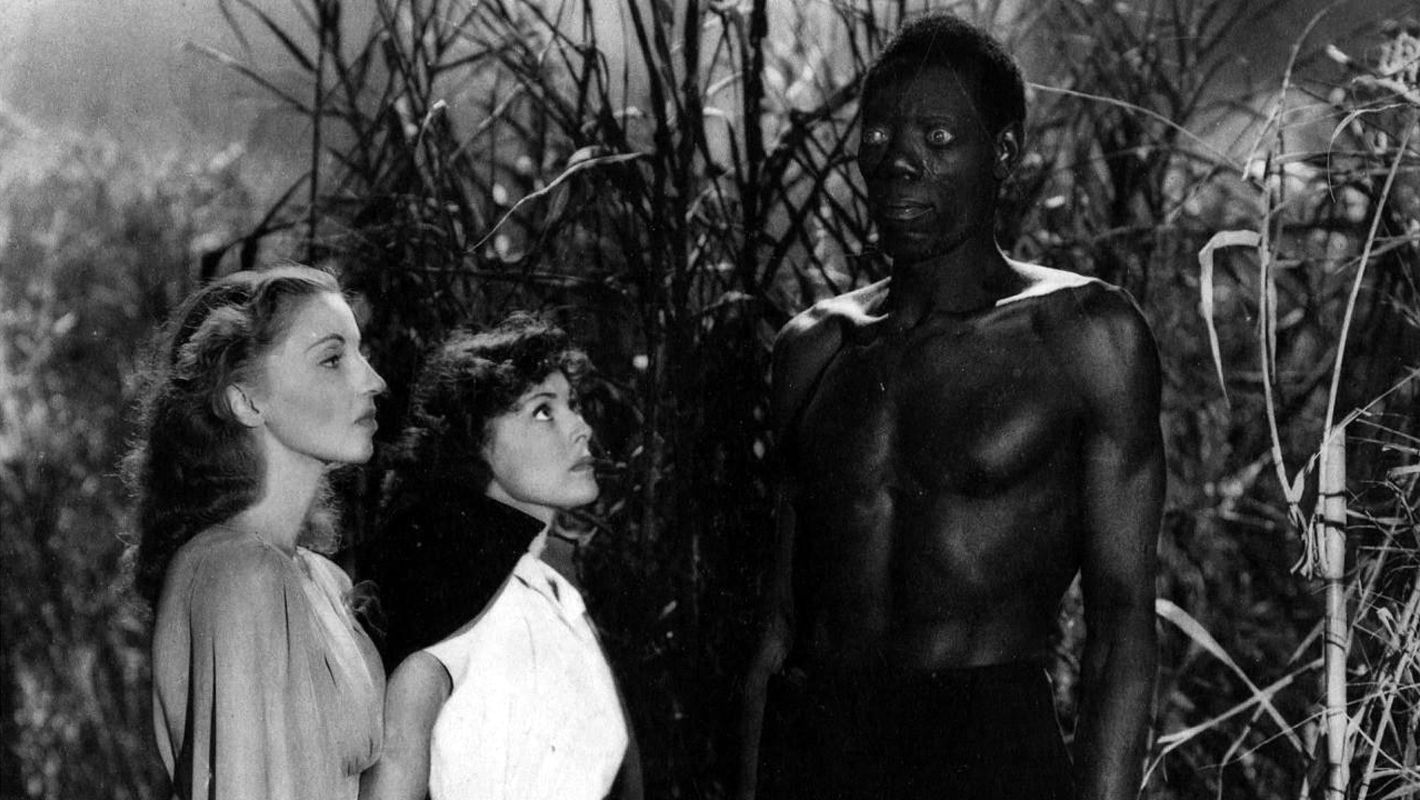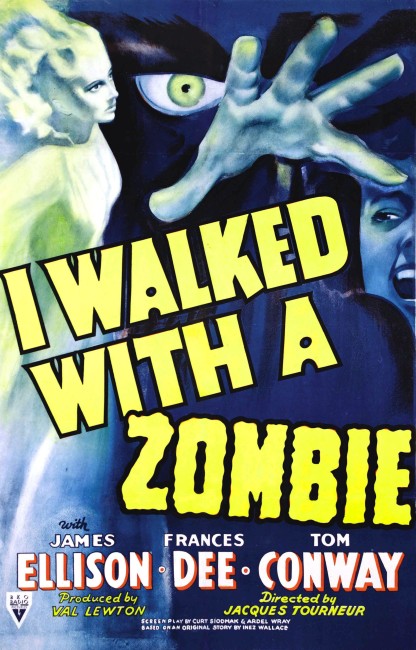USA. 1943.
Crew
Director – Jacques Tourneur, Screenplay – Curt Siodmak & Ardel Wray, Story – Inez Wallace, Producer – Val Lewton, Photography (b&w) – J. Roy Hunt, Music – Roy Webb, Art Direction – Albert S. D’Agostino & Walter E. Keller. Production Company – RKO Radio Pictures.
Cast
Frances Dee (Betsy Conwell), Tom Conway (Paul Holland), Christine Gordon (Jessica Holland), Edith Barrett (Mrs Rand), James Ellison (Wesley Rand), James Bell (Dr Maxwell), Darby Jones (Carre Four)
Plot
Nurse Betsy Conwell takes up a position on the West Indies island of St Sebastian tending Jessica, the wife of plantation owner Paul Holland, whose mind has been burned out by a tropical disease. Betsy falls in love with the melancholy Paul and seeks to help him by finding a cure for Jessica. Believing that the native witch doctors might be able to help, one night Betsy leads Jessica through the plantations to a voodoo ritual. Afterwards however, the natives become obsessed with Jessica and try to lead her back to them by voodoo. Betsy comes to realise that Jessica’s condition might not be a disease but instead caused by voodoo.
I Walked With a Zombie was the second film produced by the great Val Lewton in his brief tenure at RKO Radio Pictures in the 1940s. Beginning with the genre classic Cat People (1942), Lewton pioneered and would specialise in a unique brand of psychological horror. His horror films inhabited an ambiguous place that hung in a twilight zone where the menace on hand (be it were-cat people, vampires, ghosts or, as here, voodoo) hovered with wilful uncertainty between whether it was supernatural in origin or whether the cause was mundane and the supernatural was something that existed only in the minds of the characters on screen.
Certainly, I Walked With a Zombie belies its crude title. The title was in fact one that had been purchased by RKO from a series of newspaper articles written by Inez Wallace and given to Lewton with instructions to come up with an accompanying film. As usual, Lewton delighted in subverting or at least confounding these studio-imposed titles. Lewton later wryly referred to I Walked With a Zombie as his “Jane Eyre of the Indies”. And that is exactly what the film is – the script fairly accurately mimics Charlotte Bronte’s story about a governess falling in love with the brooding master of a big house who is found to harbour the secret of an ill wife.
The surprise about such literary allusions in a film like this is the name of Curt Siodmark on the script. German-émigré Siodmak was one of the B-budget hacks of the era, turning out scripts for the likes of The Ape (1940), Black Friday (1940), The Wolf Man (1941), Frankenstein Meets the Wolf Man (1943), Son of Dracula (1943) and authoring the oft-filmed novel Donovan’s Brain (1943). Considering Siodmak’s hackwork elsewhere – and especially in comparison to his script for the Lewton-influenced and far less subtle The Beast with Five Fingers (1946) – the literacy of the work here must have to be put down to Ardel Wray, who also wrote Lewton’s The Leopard Man (1943) and Isle of the Dead (1945).

Many consider I Walked With a Zombie to be the best of Val Lewton’s films. One’s own preference goes to Cat People. Cat People seemed a streamlined work of perpetually eerie unworldly shadows; I Walked With a Zombie by comparison operates around a more complex series of metaphors and ultimately seems much more literary and less cinematic in its atmosphere than Cat People.
Director Jacques Tourneur, who also directed Cat People, even eschews the subtle scares and set-pieces that made the Lewton film what it was – the scariest thing in this film is the image of a Calypso singer at an open air cafe who sinisterly walks towards Frances Dee singing a song about the plantation owner, his brother and wife. Instead the horror lies in the creation of an eerie and unsettling ambience. The film’s one great moment of atmosphere is the sequence everybody remembers of the dream-like walk through the plantation guided by the natives and bug-eyed Darby Jones. There is nothing directly scary about it, just the evocation of an unearthly dream-like mood.
As with all of Val Lewton’s films, I Walked with a Zombie hovers on the deliberate edge of ambiguity between whether the explanation for events is mundane or supernatural. One of the film’s most haunting images, one that subtly suggests the essence of what the Lewton film is all about, is the shipboard sequence where Frances Dee stands over the rail and comments what a beautiful sight it is, only to be rebuffed by Tom Conway by saying there is no beauty there, only death – the flying fish jump to avoid being devoured by bigger fish and the phosphorescence comes from dead bodies. “There’s no beauty here – only death and pretence.” It is a haunting tromp l’oeil image that perfectly encapsulates Lewtonian ambiguity – an image that at face value seems beautiful, while from another point-of-view at the same time exists as a sinister undertow of death and decay. (Unfortunately, the film’s budget prevents the depiction of any of the beauty and horror that the characters refer to).

The central belief/doubt ambiguity of the film hovers around the question of whether Jessica is suffering from tropical fever or has been affected by voodoo. The film sits just between rationalism and superstition – its’ duality plays on the conflict between Western Christendom and Caribbean culture, and between medicine and magic. This also made I Walked with a Zombie one of the rare attempts of the era to portray slavery, showing former slaves who have barely contained contempt for former masters.
The film was poorly remade as Ritual (2002) starring Jennifer Grey. Darby Jones subsequently appeared as a zombie in Zombies on Broadway (1945), which acts as a parody of his role here.
Val Lewton’s other horror films were Cat People (1942), The Ghost Ship (1943), The Leopard Man (1943), The Seventh Victim (1943), The Curse of the Cat People (1944), The Body Snatcher (1945), Isle of the Dead (1945) and Bedlam (1946). Val Lewton: The Man in the Shadows (2007) is a documentary about Lewton and his films.
Jacques Tourneur directed a number of Westerns and thrillers during his four decade career from the 1930s to the 1960s. He also made Cat People (1942) and The Leopard Man (1943) for Val Lewton. His other genre films are the classic strongly Lewton-influenced Night of the Demon/Curse of the Demon (1957), the Grand Guignol comedy The Comedy of Terrors (1963) and the lost city film The City Under the Sea/War Gods of the Deep (1965).
Trailer here


